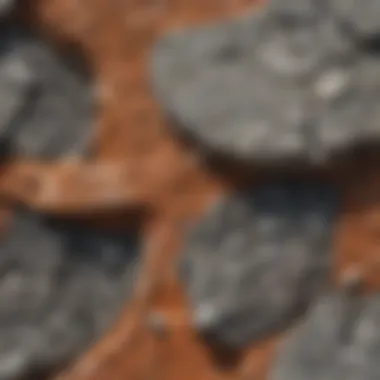Exploring Granite: Types, Names, and Origins


Intro
Granite is more than just a common building material; it is a complex igneous rock with a rich history and significant geological importance. With its durable and visually appealing nature, granite offers a wide range of types and forms, each with its distinct qualities. The exploration of granite reveals a fascinating interplay between natural processes and human endeavors. This guide aims to provide clarity on the different types of granite, their properties, and how to identify them effectively.
Understanding granite is essential for both collectors and enthusiasts. By examining its categorization, we can appreciate why certain types are favored for decorative and functional applications alike. The distinctions between various granites lie in their composition, grain size, and geographical origin. These factors contribute to their unique aesthetic and structural properties. This article will serve as a valuable resource for anyone looking to deepen their knowledge of granite, whether for personal interest or collection purposes.
In this narrative, we will begin with a featured collectible that embodies the essence of granite’s allure. Following this, we will detail identification techniques that provide insight into recognizing different granite types. Ultimately, this comprehensive overview will synthesize the salient features of granite, enhancing appreciation for this remarkable geological wonder.
Understanding Granite
Granite is one of the most enduring materials studied in geology. Its significance extends beyond mere aesthetics; it offers insight into the Earth's geological processes. Recognizing granite involves understanding its formation and characteristics. This knowledge not only serves collectors but also helps in various practical applications, from construction to art.
Formation Process
Granite forms through the slow crystallization of magma beneath the Earth's surface. This process can take thousands to millions of years. The specialized cooling allows large crystals to develop, primarily composed of feldspar, quartz, and mica. The mineral composition varies, leading to different types of granite.
Factors influencing the formation include:
- Temperature: High temperatures enable the molten rock to cool slowly, fostering crystal growth.
- Pressure: Crustal pressure affects mineral arrangement within the rock.
- Chemical Environment: The presence of water and other elements alters the granite's chemical makeup and influences mineral types.
Understanding this process unearths the fundamental principles of geology. It showcases the dynamic nature of our planet and explains why granite possesses such varied physical properties.
Characteristics of Granite
Granite is revered for its durability. The hardness and resistance to wear make it suitable for both indoor and outdoor applications. Its aesthetic appeal is notable, with a wide range of colors including pink, gray, and white. The texture can range from coarse to fine, depending on the mineral content and formation process.
Key characteristics include:
- Durability: Resistant to scratching and weathering, making it ideal for surfaces like countertops.
- Porosity: Granite is less porous than many other rocks, ensuring it is less susceptible to staining when sealed properly.
- Variation: Every granite slab is unique due to its mineral composition and crystalline structure, providing a one-of-a-kind appearance in uses.
- Thermal Stability: Granite can withstand heat, which makes it suitable for kitchen use.
"Granite's resilience and unique patterns provide both functionality and beauty, making it a favored choice in various facets of life."
Granite serves practical uses, but its formation and characteristics tell a story of the Earth’s history, showcasing the processes that have shaped our planet for billions of years.
Types of Granite
Understanding the various types of granite is essential for those interested in geology or rock collecting. Granite, being a natural igneous rock, has formed under specific conditions in the Earth's crust. These conditions traditionally influence the properties such as color, texture, and mineral composition. Recognizing the types of granite can help both collectors and enthusiasts identify unique specimens. It also provides insights into the geological history and environment where these rocks originated. In this section, we will focus on three major categories: light-colored granites, dark-colored granites, and granite textures.
Light-Colored Granites
Light-colored granites typically consist of high amounts of quartz and feldspar. These minerals often give light-colored granites a pale appearance, ranging from white to light grey. Common examples include Bianco Cristallo and Alaska white. The lighter color often reflects lower levels of iron and magnesium.
The significance of light-colored granite goes beyond aesthetics. These granites are often more prevalent in continental crusts, indicating stable geological histories. This type is widely used in countertops and flooring due to their elegant finish. Additionally, light-colored granite can enhance the brightness of a space, making it a popular choice in architecture.
Benefits of Light-Colored Granites:
- Aesthetic appeal in both residential and corporate design
- Low maintenance compared to darker varieties
- Resistant to staining due to its crystalline structure
Dark-Colored Granites
In contrast, dark-colored granites are rich in minerals like biotite, hornblende, and augite which contribute to hues ranging from deep grey to black and dark green. Notable examples are Absolute Black and Black Galaxy. The appearance of dark granites can evoke a sense of elegance and sophistication. These granites are often favored for exterior applications, such as building facades and pathways.
The geological formation of dark granites typically occurs in environments with greater heat and pressure. This results in a denser rock with potentially higher durability in various weather conditions. Their robust nature makes them suitable for outdoor landscaping. However, they can be more prone to showing scratches and stains, requiring careful maintenance.
Considerations for Dark-Colored Granites:


- Need for regular sealing to prevent staining
- Cooling effect in hot climates due to their color
- Rich hues enhance modern architectural designs
Granite Textures
The texture of granite provides immediate insight into its formation process and mineral composition. Textures can vary significantly and are generally categorized into five distinct types: aphanitic, phaneritic, porphyritic, granophyric, and pegmatitic.
- Aphanitic Texture: This indicates fine-grained formation. The crystals are not visible to the naked eye.
- Phaneritic Texture: Here, the crystals are large enough to be seen. This texture is common in most granites.
- Porphyritic Texture: This texture features larger crystals embedded in a finer-grained matrix, showing a two-stage cooling scenario.
- Granophyric Texture: A unique intermixed structure of quartz and feldspar crystals.
- Pegmatitic Texture: Noted for its extremely large crystals, usually formed during the final stages of magma cooling.
Textures can influence granite's desirability in construction and design. For example, phaneritic granites are often favored for aesthetic applications that showcase visible crystals. In contrast, aphanitic granites can be more suitable for structural installations where visibility is less important.
Understanding granite's various textures assists collectors and enthusiasts not just in identifying rocks but also in appreciating their unique formation history.
A granite's texture can hold clues to its past, revealing the conditions under which it was formed.
Popular Granite Names
Understanding popular granite names is essential for anyone involved in granite collection or utilization. Granite, being one of the most sought-after materials in construction and onyx architecture, carries names that often reflect its place of origin and unique characteristics. Familiarity with these names can aid collectors and enthusiasts in better appreciation of the material, while also guiding their purchasing decisions.
Granite Name Origins
The origins of granite names are deeply intertwined with their geographical locations. Each granite type often has a name derived from the region where it is quarried. For example, Ubatuba granite is named after the Brazilian city of Ubatuba, renowned for its rich, dark hues. Similarly, Sierra Blue granite derives its name from the Sierra Nevada region in California, reflecting not only its physical attributes but also its environmental heritage.
The name usually hints at key characteristics such as colors, patterns, and geological history. This becomes especially important when distinguishing materials in a competitive market. Knowledge of name origins also serves as a way to connect with the stories behind the stones, providing a richer context that enhances their value.
Globally Recognized Granite Types
There are numerous granite varieties recognized worldwide, each possessing distinct features that reflect its origin. Some of these globally known types include:
- Black Galaxy: Known for its beautiful black surface with golden speckles, this granite hails from India. It is often used in countertops and flooring.
- Bianco Antico: This delicately colored granite from Brazil showcases a mix of grey, white, and brown tones, making it appealing for a variety of residential applications.
- Cambrian Black: This type comes from Canada, recognized for its deep black color with a polished finish, popular in architectural uses.
These names not only resonate with the aesthetic preference of consumers but also signify the quality and sourcing of the stone. The reputation attached to these names can greatly influence market demand and pricing.
Regional Variations
Granite exhibits notable regional variations, shaped by local geological conditions and artisan quarrying techniques. For instance, granites quarried in the United States often differ significantly from those sourced in Europe or Asia.
In the U.S., New Caledonia granite features a softer palette of greys and whites. In contrast, Royal Mahogany granite from Brazil presents a rich reddish-brown color, making it a favorite in upscale applications.
These variations result from factors like mineral composition, access to specific quarry sites, and historical quarrying techniques. Collectors should appreciate these distinctions as they can affect the granite's durability, appearance, and suitability for various projects.
Understanding the differentiators in granite names and their origins contributes significantly to more informed choices in purchase and application, elevating both aesthetic and functional value.
Key Granites in Construction
Granite's role in construction is significant due to its durability and aesthetic appeal. It is a preferred choice for a variety of applications that require materials capable of withstanding wear and abrasion. Its natural resistance to weathering makes granite ideal for structures facing environmental challenges. In addition to its sturdiness, granite comes in various colors and patterns, making it a versatile material that enhances the visual aspects of both residential and commercial projects.
Commercial Use of Granite
Granite finds extensive use in commercial projects. Many buildings, bridges, and public spaces utilize granite for both functional and aesthetic purposes. The polished surface of granite provides a sophisticated look, appealing to architects and designers. Common applications include:
- Flooring: Granite tiles are popular in hotels and malls, providing a long-lasting, elegant surface.
- Countertops: Kitchen and bathroom surfaces crafted from granite are valued for their durability and ease of maintenance.
- Facades: The exterior cladding of buildings often features granite for its resilience against the elements.
Notably, granite’s longevity reduces the need for frequent replacements, making it a cost-effective choice in the long term. This sustainability aspect is attractive to both developers and environmentally conscious consumers. As construction practices evolve, the demand for granite in commercial applications continues to grow.
Granite in Monuments and Memorials


The use of granite in monuments and memorials has deep historical roots. Its inherent strength ensures that these structures endure through time, symbolizing permanence and respect for what they commemorate. From gravestones to large-scale memorials, the significance of granite in this context is profound. Here are some key points:
- Longevity: Granite can last for centuries without significant deterioration, which is essential for memorial structures.
- Symbolism: Stone represents endurance and memory, making granite a fitting material for honoring individuals or events.
- Craftsmanship: Carving intricate designs or inscriptions into granite requires skill and precision, adding a unique artistic dimension.
"Granite is not just rock; it encapsulates memories and legacies that withstand the passage of time."
Granite in the Home
Granite has emerged as a favored material in residential settings, primarily due to its aesthetic versatility and remarkable durability. Its natural patterns and hues add character to homes, making it a popular choice among homeowners and designers. The dual appeal of functionality and beauty makes granite a substantial consideration when selecting materials for various home applications.
Granite Countertops
Granite countertops serve as one of the most prominent applications of granite in the home. Known for their resistance to scratches and heat, granite countertops provide a reliable surface for cooking and food preparation. This makes them particularly appealing in kitchen designs. Furthermore, their non-porous nature means they are less susceptible to staining, provided they are properly sealed.
A variety of colors and finishes are available, offering plenty of choices to suit different styles. The natural variations in the stone can lead to unique designs, giving each countertop a one-of-a-kind appearance. Homeowners often appreciate that granite can complement various aesthetics, from modern to rustic.
"Granite countertops blend durability with elegance, creating a favored choice for many kitchens and bathrooms."
Landscape Granite
Landscape granite encompasses various uses in outdoor spaces, serving both functional and decorative purposes. It can be utilized for pathways, retaining walls, and garden accents. This form of granite adds a rugged yet refined touch to landscaping projects. Its robustness allows it to withstand various weather conditions without significant wear.
In addition to its practical uses, landscape granite can enhance the visual appeal of outdoor settings. It can be shaped into stones for decorative features, creating an element of sophistication in gardens or patios. Moreover, the varying colors and textures of granite enable homeowners to harmonize outdoor designs with existing elements of their property.
To summarize, whether through granite countertops or landscape applications, this material plays a significant role in elevating home environments. Its durability, beauty, and versatility make it a wise choice for those looking to enhance their living spaces.
Identifying Granite Types
Identifying granite types is an essential aspect of understanding this igneous rock. It involves recognizing various characteristics that differentiate one type from another. This knowledge is vital for collectors, geologists, and construction professionals alike. Being able to identify granite types enhances appreciation for the material, allowing one to choose the right type for specific applications or simply to enjoy its beauty.
The benefits of identifying granite types extend beyond aesthetics. Recognizing the specific properties of granite can influence decisions in construction, especially regarding structural integrity and durability. For instance, some granites resist scratching and staining better than others, making them suitable for high-traffic areas.
Physical Identification Methods
Physical identification of granite types largely involves observing visual characteristics and textures. Here are key methods to consider:
- Color: The base color of granite offers initial clues. Light-colored granites may range from white to light grey, while dark-colored varieties include deep blacks and blues.
- Grain Size: Examining the grain size provides insight into the cooling history of the granite. Coarse-grained varieties cool slowly beneath the earth's surface, while fine-grained options indicate a rapid cooling process.
- Feldspar and Quartz Content: Identifying the specific minerals within the granite can help distinguish types. High feldspar content gives a pinkish hue, while quartz-rich granites often have a more translucent appearance.
- Texture: The texture can be grainy, glassy, or banded. Observing these textures under a magnifying glass can reveal further distinguishing features.
In practice, one can use a hand lens to get a closer look at the mineral composition or utilize a simple color chart to match granite samples more accurately.
Geochemical Analysis
Geochemical analysis provides a scientific approach to identifying granite types. This method evaluates the chemical composition of granite samples, pinpointing unique elemental signatures. Here are the main aspects involved in this analysis:
- X-ray Fluorescence (XRF): This technique measures the elemental composition of granite. By detecting which elements are present, one can classify the granite type more accurately.
- Inductively Coupled Plasma Mass Spectrometry (ICP-MS): This method offers precise measurements of trace elements within granite. Certain trace elements can be indicators of specific granite origins.
- Petrographic Analysis: This involves microscopic examination of thin sections of granite. Identifying the mineralogy helps classify the rock more thoroughly by assessing percentages of minerals.
Together, these geochemical techniques offer a deeper layer of understanding. They help in documenting granite types for research and commercial purposes.
The combination of physical identification methods and geochemical analysis provides a comprehensive toolkit for identifying granite types effectively.
In summary, understanding how to identify granite types involves both visual inspection and scientific analysis. This skill is beneficial for anyone interested in granite, enhancing both personal enjoyment and professional application.
Preservation of Granite
Preserving granite is pivotal for several reasons. First and foremost, granite is renowned for its durability. However, without proper care and maintenance, it can become susceptible to damage from environmental factors, staining, and other forms of degradation. By understanding the significance of preservation, both collectors and users can ensure the longevity and aesthetic quality of this stone.


Care and Maintenance
The care and maintenance of granite involve straightforward yet effective strategies. Regular cleaning is essential. Using a mild soap solution can prevent the build-up of dirt and grime. Avoiding harsh chemicals is critical because they may erode the surface. It is beneficial to apply a sealant every few years to protect the granite from liquids and stains.
Key Tips for Granite Care:
- Use coasters for drinks to avoid rings.
- Clean spills immediately to prevent staining.
- Avoid abrasive pads or brushes when cleaning.
- Regularly check for chips or cracks and address them promptly.
By adopting these practices, the beauty of granite can be maintained for years. Regular care not only preserves its visual appeal but also enhances its structural integrity, making granite a lasting investment in any property.
Environmental Considerations
Considering the environment during granite preservation is vital. Granite extraction and processing can have significant ecological impacts. Responsible practices should always be a priority. Choosing to source granite from sustainable quarries ensures that natural habitats are protected.
Some Environmental Practices Include:
- Opt for locally sourced granite to reduce transportation emissions.
- Support quarries that implement sustainable extraction methods.
- Choose suppliers who prioritize environmental responsibility.
Furthermore, when maintaining granite, using eco-friendly cleaning solutions not only benefits the stone but also protects the surrounding environment. Preserving granite, in essence, also involves a commitment to preserving the Earth, ensuring that future generations can appreciate this magnificent stone as much as we do.
"Granite is not just a mount of rock; it is a legacy shaped by the Earth that warrants our utmost respect in preservation."
Future Trends in Granite Use
The granite industry is witnessing significant changes, driven by global awareness and innovation. These trends are shaping the way granite is sourced, used, and viewed in society. Future trends in granite use are critical as they not only impact environmental sustainability but also influence the aesthetic choices of architects, designers, and homeowners. By exploring these trends, we gain insights into how granite can remain relevant in an ever-evolving world.
Sustainable Practices
Sustainability is at the forefront of many industries today, and granite is no exception. Sustainable practices in granite extraction and usage focus on minimizing environmental impact while maximizing efficiency. This includes reductions in waste generated during quarrying and transportation. Many companies are now employing techniques that recycle granite cuttings, repurposing them in construction, landscaping, or even interior design.
The use of environmentally friendly adhesives and sealants during granite installation also enhances sustainability. This approach decreases harmful emissions and promotes healthier indoor air quality. Additionally, sourcing granite from local quarries can significantly cut down on transportation-related carbon footprints.
To support these efforts, consumers are becoming more discerning about the origins of the granite they choose.
- Transparency in sourcing is vital. Customers often want to know if the granite was mined responsibly.
- Certifications from authoritative bodies help indicate sustainable practices.
- Engagement with local communities, employing or providing resources to local workers, further enriches the benefits that granite offers.
Technological Innovations
Technological advancements are transforming the granite industry in profound ways. Innovations in extraction techniques have reduced the physical footprint of quarries. Methods such as diamond wire saws create less waste and allow for more precise cutting. Furthermore, advanced machinery enables the production of thinner slabs, reducing their weight without compromising integrity. This approach not only conserves resources but reduces shipping costs.
Innovations also extend to design. Software tools allow for complex cut patterns and custom designs that were not possible before, giving architects and designers greater freedom. Additionally, 3D printing technology is beginning to make waves with granite-based materials, offering unique applications across different fields.
Moreover, the integration of augmented reality is allowing consumers to visualize how different types of granite will look in their space before making a purchase. This can decrease the rate of returns and overall dissatisfaction with products.
"Tomorrow's granite market will be as much about design and sustainability as it is about durability."
In summary, the future of granite use hinges significantly on sustainable practices and technological innovations. This dual-focus not only supports the environment but also meets the aesthetic and practical demands of modern society.
Epilogue
The conclusion of this article underscores the multifaceted role granite plays within society and the various contexts of its significance. Granite is not just an aesthetically pleasing rock; it serves as a cornerstone for construction, art, and history. Its durability, historical significance, and universal appeal make it a relevant subject in many fields, including geology, architecture, and even cultural studies.
Impact of Granite on Society
Granite has made profound impacts on society from ancient civilizations to modern architecture. Its usage can be observed in numerous structures, monuments, and as decorative finishes. In ancient Egypt, granite was essential for creating massive structures and religious monuments. The resilience of granite allows structures to withstand the test of time, preserving our architectural heritage.
Moreover, granite's aesthetic qualities contribute significantly to its desirability. It is favored for countertops, tiles, and other surfaces in homes and commercial spaces. This not only enhances visual appeal but also increases the value of properties. The demand in the housing market further stimulates the mining and quarrying industries, which employ thousands of individuals worldwide.
"Granite is more than just a rock; it is an integral part of our environment and history."
Additionally, granite collections can enrich personal experiences for enthusiasts and collectors. Owning and studying different types and colors of granite can foster deeper insights into geology and the Earth's processes. This passion for granite can lead to community engagement, wherein collectors share knowledge and showcase their finds.



